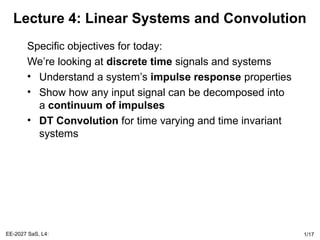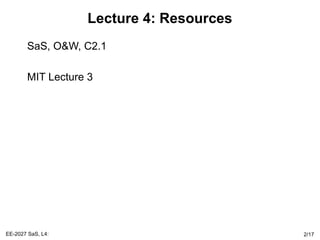This lecture discusses linear time-invariant (LTI) systems and convolution. Any input signal can be represented as a sum of time-shifted impulse signals. The output of an LTI system is determined by its impulse response h[n] using convolution. Convolution involves multiplying and summing the input signal with time-shifted versions of the impulse response. This allows predicting a system's response to any input based only on its impulse response. Examples show calculating convolution by summing scaled signal segments and using the non-zero elements of h[n]. Exercises include reproducing an example convolution in MATLAB.


![EE-2027 SaS, L4: 3/17
Introduction to Convolution
Definition Convolution is an operator that takes an input
signal and returns an output signal, based on knowledge
about the system’s unit impulse response h[n].
The basic idea behind convolution is to use the system’s
response to a simple input signal to calculate the
response to more complex signals
This is possible for LTI systems because they possess the
superposition property (lecture 3):
∑ +++== k kk nxanxanxanxanx ][][][][][ 332211
∑ +++== k kk nyanyanyanyany ][][][][][ 332211
System y[n] = h[n]x[n] = δ[n]
System: h[n] y[n]x[n]](https://image.slidesharecdn.com/lecture4-131002071517-phpapp01/85/Lecture4-Signal-and-Systems-3-320.jpg)
![EE-2027 SaS, L4: 4/17
Discrete Impulses & Time Shifts
Basic idea: use a (infinite) set of of discrete time impulses to
represent any signal.
Consider any discrete input signal x[n]. This can be written
as the linear sum of a set of unit impulse signals:
Therefore, the signal can be expressed as:
In general, any discrete signal can be represented as:
∑
∞
−∞=
−=
k
knkxnx ][][][ δ
≠
=
=−
≠
=
=
−≠
−=−
=+−
10
1]1[
]1[]1[
00
0]0[
][]0[
10
1]1[
]1[]1[
n
nx
nx
n
nx
nx
n
nx
nx
δ
δ
δ
]1[]1[ +− nx δ
actual value Impulse, time
shifted signal
The sifting property
+−+++−++−+= ]1[]1[][]0[]1[]1[]2[]2[][ nxnxnxnxnx δδδδ](https://image.slidesharecdn.com/lecture4-131002071517-phpapp01/85/Lecture4-Signal-and-Systems-4-320.jpg)
![EE-2027 SaS, L4: 5/17
Example
The discrete signal x[n]
Is decomposed into the following
additive components
x[-4]δ[n+4] +
x[-3]δ[n+3] + x[-2]δ[n+2] + x[-1]δ[n+1] + …](https://image.slidesharecdn.com/lecture4-131002071517-phpapp01/85/Lecture4-Signal-and-Systems-5-320.jpg)
![EE-2027 SaS, L4: 6/17
Discrete, Unit Impulse System Response
A very important way to analyse a system is to study the
output signal when a unit impulse signal is used as
an input
Loosely speaking, this corresponds to giving the system
a kick at n=0, and then seeing what happens
This is so common, a specific notation, h[n], is used to
denote the output signal, rather than the more
general y[n].
The output signal can be used to infer properties about
the system’s structure and its behaviour.
System h[n]δ[n]](https://image.slidesharecdn.com/lecture4-131002071517-phpapp01/85/Lecture4-Signal-and-Systems-6-320.jpg)
![EE-2027 SaS, L4: 7/17
Types of Unit Impulse Response
Looking at unit impulse
responses, allows you to
determine certain system
properties
Causal, stable, finite impulse response
y[n] = x[n] + 0.5x[n-1] + 0.25x[n-2]
Causal, stable, infinite impulse response
y[n] = x[n] + 0.7y[n-1]
Causal, unstable, infinite impulse response
y[n] = x[n] + 1.3y[n-1]](https://image.slidesharecdn.com/lecture4-131002071517-phpapp01/85/Lecture4-Signal-and-Systems-7-320.jpg)
![EE-2027 SaS, L4: 8/17
Linear, Time Varying Systems
If the system is time varying, let hk[n] denote the response
to the impulse signal δ[n-k] (because it is time varying,
the impulse responses at different times will change).
Then from the superposition property (Lecture 3) of linear
systems, the system’s response to a more general input
signal x[n] can be written as:
Input signal
System output signal is given by the convolution sum
i.e. it is the scaled sum of impulse responses
∑
∞
−∞=
=
k
k nhkxny ][][][
∑
∞
−∞=
−=
k
knkxnx ][][][ δ](https://image.slidesharecdn.com/lecture4-131002071517-phpapp01/85/Lecture4-Signal-and-Systems-8-320.jpg)
![EE-2027 SaS, L4: 9/17
Example: Time Varying Convolution
x[n] = [0 0 –1 1.5 0 0 0]
h-1[n] = [0 0 –1.5 –0.7 .4 0 0]
h0[n] = [0 0 0 0.5 0.8 1.7 0]
y[n] = [0 0 1.4 1.4 0.7 2.6 0]](https://image.slidesharecdn.com/lecture4-131002071517-phpapp01/85/Lecture4-Signal-and-Systems-9-320.jpg)
![EE-2027 SaS, L4: 10/17
Linear Time Invariant Systems
When system is linear, time invariant, the unit impulse
responses are all time-shifted versions of each other:
It is usual to drop the 0 subscript and simply define the
unit impulse response h[n] as:
In this case, the convolution sum for LTI systems is:
It is called the convolution sum (or superposition sum)
because it involves the convolution of two signals x[n]
and h[n], and is sometimes written as:
[ ]knhnhk −= 0][
[ ]nhnh 0][ =
∑
∞
−∞=
−=
k
knhkxny ][][][
][*][][ nhnxny =](https://image.slidesharecdn.com/lecture4-131002071517-phpapp01/85/Lecture4-Signal-and-Systems-10-320.jpg)
![EE-2027 SaS, L4: 11/17
System Identification and Prediction
Note that the system’s response to an arbitrary input signal is
completely determined by its response to the unit impulse.
Therefore, if we need to identify a particular LTI system, we
can apply a unit impulse signal and measure the system’s
response.
That data can then be used to predict the system’s response
to any input signal
Note that describing an LTI system using h[n], is equivalent to a
description using a difference equation. There is a direct
mapping between h[n] and the parameters/order of a
difference equation such as:
y[n] = x[n] + 0.5x[n-1] + 0.25x[n-2]
System: h[n]
y[n]x[n]](https://image.slidesharecdn.com/lecture4-131002071517-phpapp01/85/Lecture4-Signal-and-Systems-11-320.jpg)
![EE-2027 SaS, L4: 12/17
Example 1: LTI Convolution
Consider a LTI system with the
following unit impulse response:
h[n] = [0 0 1 1 1 0 0]
For the input sequence:
x[n] = [0 0 0.5 2 0 0 0]
The result is:
y[n] = … + x[0]h[n] + x[1]h[n-1] + …
= 0 +
0.5*[0 0 1 1 1 0 0] +
2.0*[0 0 0 1 1 1 0] +
0
= [0 0 0.5 2.5 2.5 2 0]](https://image.slidesharecdn.com/lecture4-131002071517-phpapp01/85/Lecture4-Signal-and-Systems-12-320.jpg)
![EE-2027 SaS, L4: 13/17
Example 2: LTI Convolution
Consider the problem
described for example 1
Sketch x[k] and h[n-k] for any
particular value of n, then
multiply the two signals and
sum over all values of k.
For n<0, we see that x[k]h[n-k]
= 0 for all k, since the non-
zero values of the two
signals do not overlap.
y[0] = Σkx[k]h[0-k] = 0.5
y[1] = Σkx[k]h[1-k] = 0.5+2
y[2] = Σkx[k]h[2-k] = 0.5+2
y[3] = Σkx[k]h[3-k] = 2
As found in Example 1](https://image.slidesharecdn.com/lecture4-131002071517-phpapp01/85/Lecture4-Signal-and-Systems-13-320.jpg)
![EE-2027 SaS, L4: 14/17
Example 3: LTI Convolution
Consider a LTI system that has a step
response h[n] = u[n] to the unit
impulse input signal
What is the response when an input
signal of the form
x[n] = αn
u[n]
where 0<α<1, is applied?
For n≥0:
Therefore,
α
α
α
−
−
=
=
+
=
∑
1
1
][
1
0
n
n
k
k
ny
][
1
1
][
1
nuny
n
−
−
=
+
α
α](https://image.slidesharecdn.com/lecture4-131002071517-phpapp01/85/Lecture4-Signal-and-Systems-14-320.jpg)
![EE-2027 SaS, L4: 15/17
Lecture 4: Summary
Any discrete LTI system can be completely determined by
measuring its unit impulse response h[n]
This can be used to predict the response to an arbitrary input
signal using the convolution operator:
The output signal y[n] can be calculated by:
• Sum of scaled signals – example 1
• Non-zero elements of h – example 2
The two ways of calculating the convolution are equivalent
Calculated in Matlab using the conv() function (but note that
there are some zero padding at start and end)
∑
∞
−∞=
−=
k
knhkxny ][][][](https://image.slidesharecdn.com/lecture4-131002071517-phpapp01/85/Lecture4-Signal-and-Systems-15-320.jpg)
